3 - The problem of waste disposal
With the creation of the aqueduct that conveyed the waters of the Argallo River to Sanremo, the municipal administration had created the most important prerequisite to solve the hygienic issue; it was now able to dispose of a sufficient quantity of water to wash the streets and the drains and to flush the sewers.
In the wake of the enthusiasm that the inauguration of the aqueduct aroused in the town, the Town Council decided to build a general sewerage system, but reserved the right to leave the project in abeyance, both because of the uncertainty of the best system to adopt and because of the insufficient financial means available.
In view of the economic possibilities and technical knowledge available at the time, a sewerage system was not an easy problem to solve. It was not until the second half of the 19th century that a number of European cities undertook such efforts, and the technology they employed was still largely experimental. Moreover, although there had been a heated debate on the effectiveness of the various systems for twenty years, there was absolutely no agreement among the scientists involved in these studies.
The reason for the sudden interest that the sewage question polarised was
«...without doubt, in the recognition that this question is closely related to how many other studies are being carried out to know the cause and origins of infectious mysmatico-contagious diseases, and to find the means to prevent and combat them. For it has been recognised beyond any doubt by physicians and hygienists that the cleanliness and clarity of the ground underneath buildings and public streets has an absolute influence on the purity of the air in dwellings and on the health of those who live there.
It was recognised that the germs of some of the dominant morbid infections, called bacterium, bacilli, microbes or whatever, when they are outside of living organisms, have their seat and life in the excretions emitted by those who were affected by the infections themselves, and that these germs propagate with great rapidity through the air and water, preserve their vitality in the excretions and rejection materials for a very long time. It can therefore be established, from this point of view, that the removal of waste materials from built-up areas as quickly as possible and in the best possible way is the primary duty of those responsible for the public good ».
Until the '70s, in the Sanremo area, the problem of collecting and evacuating rubbish and faecal matter from houses was not considered a problem affecting the community as a whole, and therefore falling on the shoulders of the municipal administration, but rather a problem concerning individual citizens, who provided their own houses with cesspits and periodically took care of emptying and transporting the excrement and household waste. The tasks of the municipality were completed with the evacuation of rainwater from the town, which was collected in special drains.
So in Sanremo, as in almost all Ligurian towns, there was only a rudimentary system of white canals, built under the street floor or on the surface, on one side of the streets. These canals generally introduced the "meteoric" water into the torrents or directly into the sea; only in some cases, similarly to what happened for the discharge water of some fountains, the white canals led the rainwater to lands surrounding the built-up area, where it was used for irrigation.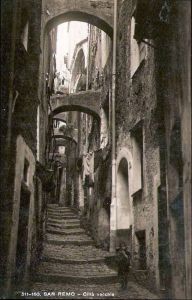 Such a system of small-scale drainage canals, designed exclusively to convey rain, had a serious defect. Rubbish of various kinds often ended up in the pipes, which stagnated and gave off pestilential fumes. This organic matter eventually clogged the channels, causing the roadbed to swamp.
Such a system of small-scale drainage canals, designed exclusively to convey rain, had a serious defect. Rubbish of various kinds often ended up in the pipes, which stagnated and gave off pestilential fumes. This organic matter eventually clogged the channels, causing the roadbed to swamp.
Rainwater hardly ever had the necessary pressure to unclog the pipes, taking the waste with it into the streams. But when this did happen, the organic substances ended up rotting in the bed of the dried-up streams.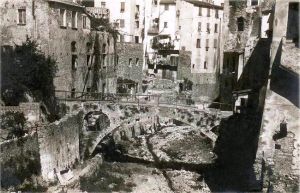 This situation, which was already unhygienic in itself, was complicated by the fact that many houses built near the city's watercourses fed their excrement and waste water directly into them. As a result, further deposits of fetid and putrescent matter formed in the riverbeds of the streams, « especially during the long dry periods, which certainly do not enhance the reputation of San Remo's balsamic breezes, so sought after by tourists ».
This situation, which was already unhygienic in itself, was complicated by the fact that many houses built near the city's watercourses fed their excrement and waste water directly into them. As a result, further deposits of fetid and putrescent matter formed in the riverbeds of the streams, « especially during the long dry periods, which certainly do not enhance the reputation of San Remo's balsamic breezes, so sought after by tourists ».
This serious problem was not solved even when the Carli aqueduct was completed in 1828 and the administration had a considerable amount of water available for the hygiene needs of the town. In fact, the water from the new pipeline, introduced at great pressure, was able to rinse the drainage canals, but not to carry away the rubbish from the riverbeds. For more than six months a year, therefore, the San Romolo, the San Francesco and the San Lazzaro were uncovered and stagnant sewage pipes.
Until the '70s, Sanremo depended on a system of "dry toilets", consisting of a hole in the floor of the building. This consisted of a hole in the floor of the house toilets, which was the end of a vertical conduit with an outlet into a room on the ground floor, where there was usually a cesspit. Liquid and solid organic substances produced by the users of the latrines, and sometimes the household garbage itself, were precipitated down the conduit without the aid of water, and ended up in the cesspit or in the collection tank, or simply accumulated in the room that housed them, until lack of space forced their removal.
The systems relied upon for the collection of excreta in the houses were different: there was the system of impermeable cesspools, the system of absorbent cesspools, the system of portable cesspools and the system of storage rooms. The first and third systems required a small amount of capital for their construction and installation and were generally used in bourgeois houses, while the second and fourth systems, which were easy to implement, were usually used in working-class houses. On the whole, the absorbent and impermeable cesspools were by far the most widely used expedient in San Remo.
The drawbacks that doctors and scientists recognised in the cesspool system were several. In the first place, whether they were absorbent or not, they were not waterproof, because even the masonry walls were subject to infiltration over time.
« ...it therefore happens that after a certain time the ground around the cesspools remains infected and soaked, for a more or less large area, depending on the greater or lesser porosity of the surrounding soil, with unclean and putrescible matter that makes the area we breathe infected and unhealthy and harmful. Nor is it difficult to understand how this infection can reach us.
The lowering of the underground water table draws in atmospheric air as a substitute, which penetrates into the cavities and porosities of the soil, overloading it with infected gases, while the subsequent raising of the water current in the permeable layer drives the infected air out of the vacuoles in the soil and into the inhabited areas. This exchange of air between the soil and the atmosphere occurs quite continuously and rapidly, especially in rainy seasons, and it is easy to see how it can exert a considerable influence on our dwellings ».
Secondly, the serious drawback of cesspools was that
« ...of the fetid emanations which from the upper tanks rise up to infect the flats one above the other, following the route of the pipes intended for the removal of excrement. By adopting cesspits of considerable size, so as not to be forced to evacuate too frequently the materials introduced into them, the result is that the excrement and domestic waste, remaining there in considerable quantities, in an atmosphere lacking in oxygen, undergo a kind of putrid fermentation, giving rise to deleterious gases such as ammonia, carbonic acid, carbon monoxide, hydrogen sulphide, a large part of which spreads in the homes ».
The cesspools, however, were seen as a necessary evil as they were of great importance to the economy of the San Remo area. The soil in Liguria is very poor, largely rocky and in the remaining part not very fertile.
Fertilising the land was an indispensable measure to make the harvest less thankless.
Chemical fertilisers were not yet used in the '80s and guano was very expensive. Fertilisation, and therefore the level of agricultural productivity in the San Remo area, thus depended to a large extent on the ability of the inhabitants of the capital to produce abundant and well-nitrogenated excrement.
This meant that the town's cesspits were emptied by the local farmers themselves, who for a long time were even prepared to pay for the precious material. But when the competition from guano began, the owners had to resign themselves to giving the farmers the contents of the wells in exchange for cleaning them.
The increased water supply that Sanremo had at its disposal, thanks to the Marsaglia aqueduct, inaugurated on March 12, 1885, created a great problem of survival for this age-old and tested system of evacuation of liquid and solid droppings. In fact, the new large quantity of water ended up, after domestic use, in the latrines.
Even, now that the fashion for the water closet was in vogue, thousands of litres of clean water ended up daily in cesspools. The result was that the excrement that was so useful for agriculture was disproportionately diluted and farmers began to lose interest in a product that had become inefficient and difficult to transport.
They began to pay for the service of emptying the wells, which now had to be carried out more frequently, as the pits filled up more quickly because of the water. And nobody liked the turn of events: it displeased the farmers, who lost the possibility of using large quantities of fertiliser free of charge, and it displeased the owners and tourists, who were financially damaged by the events, but above all who were now disturbed too often by the emptying of the pits.
In short, the municipal administration had done the right thing in deciding to build the sewer; this seemed to be the only solution to a problem that was becoming increasingly entangled.
However, the resolution of 28 May 1885 was more of a stratagem to gain time; the municipal finances were not flourishing after the aqueduct was built and the administrators were well aware that the sewerage system, even if it had been approved, could not be built for a long time.
However, time exacerbated the problems that were on the table. Between the end of the eighties and the beginning of the new century, in fact, the habit of illegally connecting cesspools to street canals became widespread in San Remo.
It was enough for the owners to connect the upper part of the pits to the sewage pipes, so that the liquid content could flow out; what remained of the solids could be sold to the farmers.
Technical comment:
In the 19th century, three different sewerage systems were tested: the mixed sewerage system, with large (French system) or small (German system) ducts; the separate sewerage system with continuous circulation (English system); the simple separate sewerage system (American system).
The mixed sewerage system provided for the creation of a single network of underground canals to receive waste material, kitchen waste water, rainwater, industrial waste water, public and private washing facilities, slaughterhouses, etc., and to evacuate it from inhabited areas into rivers or the sea, or to irrigate the countryside. This was the system adopted in large European cities such as London, Brussels and Paris, where there were two types of channels: the collecteurs and the égouts (collectors and sewers). The égouts, to which the secondary arteries coming from the houses were connected, ran under the streets and collected the water and unclean matter and poured it into the collecteurs, or main canals, which flowed downstream into the Seine.
This system was also in use in Berlin, Hamburg and Frankfurt, but instead of large-section conduits, small ovoid conduits were used, suitably fed by water to prevent the stagnation of waste materials.
The mixed sewer system was opposed by many scientists, who believed that sewage could, regardless of the quality of the materials used in their construction, seep through the walls of the pipes and pollute the surrounding soil.
Another serious drawback of this system was the formation of deleterious gases in the channels, produced by the fermentation of stagnant putrid matter, which were able to rise up to the houses. And this explained why once
« ...once the epidemic is introduced into a large city, it is impossible to stop it; it spreads certainly and rapidly through this underground and dark maze, which like a huge madrepora with a thousand tentacles, embraces in its fatal grip all the houses, all the families, and brings sickness and death there ».
The system of separate sewers with continuous circulation, used mainly in England, consisted of two sets of pipes: one for rainwater, the other for waste water and manure. For the latter, a continuous circulation was established by means of a special water conduit, which was fed into the sewage circuit and which, having entered pure, came out loaded with fertilising materials.
The conduits led this water to the countryside, where it was used for irrigation. The canalisation, in this system, was generally made of cast iron with large section pipes. In order to function, however, many litres of water per inhabitant were needed to be fed into the circuit every day.
The simple separate sewer system, widely used in the United States, involved the separation of rainwater and sewage pipes. At the upper end of the secondary channels of the rainwater circuit there were special inflow cisterns by means of which a considerable quantity of water could be poured into the channels, thus obtaining their rapid flushing. However, this system not only required a lot of water, it also needed steep slopes. It also required the dispersal of waste matter into rivers or seas.
The first project of a general sewerage system for the city of Sanremo was elaborated by the Asquasciati administration in 1890 and foresaw the construction of three large collectors in the bed of the San Romolo, San Lazzaro and San Francesco streams and secondary collectors to be carried out along the main city streets.
The system adopted by the plan was that of "tout à l'égout" (drainage).
Rainwater, rejection water and waste material were to be dispersed into the sea at a suitable distance from the shore in the section facing the town.
The second project, by engineers Losio and Pagliani of Turin, drawn up in 1901, was undoubtedly more complex and articulated than the previous one. The system they adopted was that of a simple separate sewerage system, using a convenient distribution of automatic water "outlets". The sewage was to flow into the sea, a hundred metres away from the beach, at the level of the San Bernardo stream, purified using the biological system.
The project provided for the construction of four main collectors running parallel to the beach, along Via Cavallotti - Garibaldi - Palazzo, Via Vittorio Emanuele, Via Roma and Corso Carlo Alberto, on which the secondary street canals converged, collecting the sewage from the houses through tertiary pipes, The secondary street canals converged on these, collecting the sewage from the houses through tertiary pipes, sloping from top to bottom so that the water and filthy matter could be channelled towards the lowest part of the city, eighty metres west of the railway station, along Corso dell'Imperatrice, from where a single general sewer would take the sewage to the mouth of the Bernardo stream.
The last general sewerage project drawn up for Sanremo before the World War was that of the firm Zucchetti & Brugnatelli of Milan, dated 1912. The two engineers from Lombardy agreed with their predecessors from Piedmont that the system of mixed sewerage should be discarded and that the simple separate sewerage should be adopted, which was better suited to the topographical characteristics of the town.
« Under the new Zucchetti-Brugnatelli project, the city's water is disposed of by two main collectors: a western collector which collects the sewage from the city centre and the western region and pours it into the sea near the cemetery; and a smaller collector towards the east which conveys the sewage from the corresponding region and pours it into the sea beyond San Martino ».
Even during the debate on the sewerage issue in the town council meetings, the split between "pro-tourists" and those in favour of development based on traditional economic activities continued. The former wanted the general sewerage system in order to solve the hygiene problem once and for all, to prevent epidemics and to satisfy the wishes of the foreign colonies; the latter - whose watchword was laissez-faire - opposed its construction, mainly because they were concerned about the repercussions that the end of the large supply of fertiliser would have on agriculture.
There was also a centrist group within the municipal council, who wanted the problem of disposing of urban waste to be solved without depriving agriculture of the fertiliser it needed. In Sanremo, this meant no sewage system, as it was not possible at the time, due to the high costs involved, to channel the sewage to the cultivated land, almost all of which was hilly.
The most representative figure of this faction was the engineer Giacomo Picconi, municipal councillor and then councillor in the last period of the Asquasciati administration, author of an important study on the sewerage issue. Picconi was a firm believer in strict regulation of sewage evacuation methods and advocated the adoption of the system of mobile ditches for the complete removal of liquid and solid excrement, which was successfully practised in many German cities.
« The service of these pits is very simple, if they have been set up large enough, all the more so because they can be done very usefully by a company set up for this purpose. The establishment of such a company would not require a great deal of start-up capital. The mobile pits could also be used oil barrels, suitably circled and fitted with a hermetically sealed lid.... Two barrels per house would be sufficient for the replacement.
The removal of these barrels would be done periodically every four or five days, at the most convenient times of the night, without causing annoyance or disturbance to the tenants, by means of wagons on which the empty replacement barrels could be transported and the full ones exported ».
To solve the problem of the evacuation of urban waste, in Sanremo, between 1885 and 1915, a general sewerage system was not built, as hoped by the "pro-tourist" bourgeoisie gathered around the mayor-banker Asquasciati; the system of cesspools was not made compulsory, as wanted by the technicians represented in the council by the engineer Picconi; nor was any action taken, as demanded by councillor Viale and other exponents of the "anti-tourist" party.
The measures that were taken, however, were such that no side was completely dissatisfied. In fact, some sewers were built, the sewage evacuation system was regulated, but at the same time the discharge of sewage into the street canals was tolerated.
At the end of the century there were two different kinds of unauthorised sewage connections: those connecting cesspits, generally in their upper part, to the street canals, and those connecting latrine conduits directly to the stream bed. In the first case, only liquid excrement ended up in the bed of the San Romolo, San Francesco and San Lazzaro streams, while in the second case all the substances thrown down the gargoyles of the toilets ended up there: liquid excrement, faecal matter, domestic water and even rubbish.
The municipality tolerated this situation, considering it to be temporary, and thought that in a short time, with the construction of the general sewerage system for the town, the matter would resolve itself. However, no sewerage system was built for the entire period in question, and the fear of the stench emanating from the torrents often led to petitions and letters of protest addressed to the public administrators.
However, the municipal council remained largely deaf to these complaints and sometimes even authorised the construction of private sewers, reserving the right to use these illegal connections. On this point, the "anti-tourists" in favour of laissez-faire had undoubtedly won.
In clear contradiction to this permissive attitude, however, in 1883 the administration approved the new hygiene regulations, which contained important norms aimed at rationalising the system of collection and disposal of urban waste, norms whose "Picconian" matrix could be felt.
« The articles of the San Remo hygiene regulations for the soil and the built-up area prohibited the connection of cesspools and latrine ducts to streams and white canals; they banned the system of absorbent wells and storage rooms, while authorising impermeable cesspools and mobile cesspools; they required latrines to have siphons, hermetic closures, hydraulic devices for draining water and vent pipes for noxious gases; They introduced a compulsory odourless draining of pits; they fixed night-time hours for cleaning and emptying wells and for transporting faecal matter; they prohibited the use of natural fertiliser in the urban area; they required owners to connect their cesspits to the general sewerage system once it had been built; and they prohibited the dumping of rubbish on meadows or in streams.
Fines and penalties were envisaged for those who transgressed these rules, but of course these were not simple administrative measures that could solve the problem of the hygienic conditions of urban streams ».
A third type of measure taken by the municipal council between 1885 and 1915 on the issue of urban waste disposal concerned the construction of sewers and the development of the city's stream beds with a view to their future conversion into sewerage collectors.
This was the first step towards the construction of a general sewerage system for the town, the main demand of the pro-tourist camp.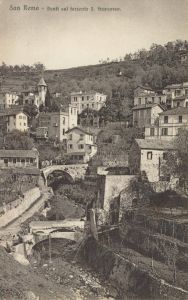 Sewer lines were built to connect public buildings such as the abattoir, hospital, station, wash-houses and public toilets, which required constant disposal of large quantities of water and unclean materials, and along the main town streams. The sewage was discharged into the sea in the stretch facing the town.
Sewer lines were built to connect public buildings such as the abattoir, hospital, station, wash-houses and public toilets, which required constant disposal of large quantities of water and unclean materials, and along the main town streams. The sewage was discharged into the sea in the stretch facing the town.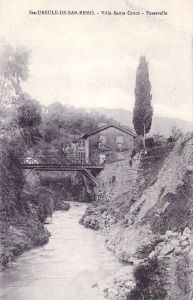 The San Romolo, San Francesco, San Lazzaro and Foce streams were therefore provided with sewage pipes a few years later.
The San Romolo, San Francesco, San Lazzaro and Foce streams were therefore provided with sewage pipes a few years later.
However, the hygienic condition of the streams, although improving, remained precarious, especially because of the numerous illegal sewer connections.
In the new century, the beds of the San Francesco, San Lazzaro and Foce were partially covered and restored, and the San Romolo, the city's most unhygienic stream, was completely covered and restored.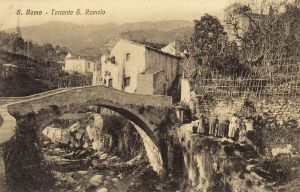 The history of the latter is emblematic. It was partially covered as early as 1878/79, when Corso Umberto I was built. In the 1990s, plans were made to cover it completely, reorganise its bed and transform it into a sewage conduit. However, the current administration simply built a sewer along its bank.
The history of the latter is emblematic. It was partially covered as early as 1878/79, when Corso Umberto I was built. In the 1990s, plans were made to cover it completely, reorganise its bed and transform it into a sewage conduit. However, the current administration simply built a sewer along its bank.
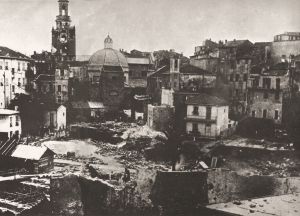 In 1902 part of its bed was paved, joining the garden in front of the Convent of the Turchine with the small square behind the Church of San Siro (then called Market Square), creating what was to become the new Market Square.
In 1902 part of its bed was paved, joining the garden in front of the Convent of the Turchine with the small square behind the Church of San Siro (then called Market Square), creating what was to become the new Market Square.
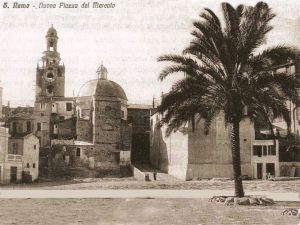
In 1910 a second partial covering was carried out to make it possible to enlarge the Market Square. 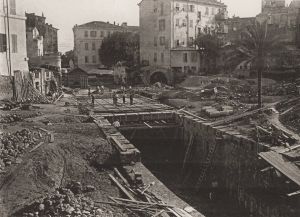 In 1912 it was again decided to cover it completely; the Natta-Soleri administration then asked for recognition of the public utility of the work and the
In 1912 it was again decided to cover it completely; the Natta-Soleri administration then asked for recognition of the public utility of the work and the 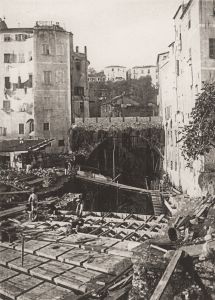 granting of a soft loan to make the work possible.
granting of a soft loan to make the work possible.
Between 1913 and 1914 the roofing was extended to Via Morardo and the Ciapella Bridge, thus completing the square, which in 1917 was named after Sanremo's Heroes.
Then came the war and the question of the hygienic conditions of San Romolo was put aside.
In the post-war period, however, it was discussed again.
In 1918, in fact, a popular petition reported the seriousness of the situation directly to the prefect, who commissioned the health inspector to carry out an inspection.
The results of this inspection confirmed the need to take care of this watercourse again.
« The San Romolo torrent, as it flows through the built-up area, receives water from oil mills, waste water from houses and wash-houses, and all the other sewage and domestic waste that is illegally poured into it by the tenants of the houses next door, as well as water from washing the streets. The bed of the torrent, both in the uncovered part and in the part below the streets, is for the most part permeable, with such slopes and counter-slopes as to form here and there more or less deep pools, where the water stagnates and decomposes. The bottom of these puddles consists of a layer of decomposing slime from which bubbles of putrid gas are continually rising; which sometimes, and because of their abundance, and the action of certain winds, invade nearby houses, forcing the tenants to barricade themselves in them....»
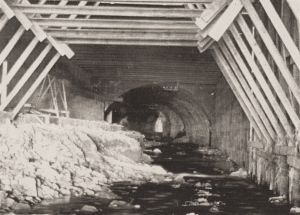 The health officer recommended paving over the river bed and covering it completely, but the mayor, when forwarding the report to the prefect, added: « I believe that this is not the time to solve the complex problem of settling the streams that flow through the town, which is connected with the problem of the town sewage system ».
The health officer recommended paving over the river bed and covering it completely, but the mayor, when forwarding the report to the prefect, added: « I believe that this is not the time to solve the complex problem of settling the streams that flow through the town, which is connected with the problem of the town sewage system ».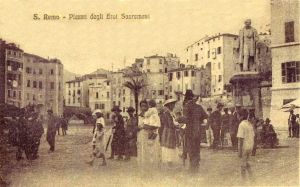 This consideration stemmed from the fact that the worst hygiene situation in the streams was naturally in the summer, when the heat caused the organic substances in the stream beds to rot. In contrast, during the tourist season, which began in October and ended in April, the rains provided sufficient water to remove these substances from the riverbeds; furthermore, the low winter temperature prevented the rapid decomposition of the waste and finally the action of the sea winds swept away the miasmatic effluents.
This consideration stemmed from the fact that the worst hygiene situation in the streams was naturally in the summer, when the heat caused the organic substances in the stream beds to rot. In contrast, during the tourist season, which began in October and ended in April, the rains provided sufficient water to remove these substances from the riverbeds; furthermore, the low winter temperature prevented the rapid decomposition of the waste and finally the action of the sea winds swept away the miasmatic effluents.
However, there was no shortage of complaints and protests, especially from citizens who lived in the town all year round.
The municipality's resources were abundant thanks to tourism, but not infinite. In fact, it found the funds to build a new hospital with an adjoining disinfection service or to municipalise the Aqueduct, but it could not find the sum that was needed to equip itself with a modern sewage system.
Once again, therefore, the resolution of the problem of the hygienic conditions of the urban streams, under the illusion that the sewerage system would soon be built, was postponed.
However, until the thirties, no administration undertook the financial burden that such a construction would entail, and for this reason we can conclude that, in spite of the efficiency achieved by the urban cleaning service, the sanitary organisation and the water supply, the hygienic issue in Sanremo of the belle époque was never completely resolved.
As soon as the tourists left, the residents had to live with the effluents of the torrents, full of excrements, garbage and waste water.
But Sanremo was a "ville pour les autres" and the problems were taken into consideration only when they had a direct and harmful influence on the life of the foreign colony; the huge expenses were tolerated only when they were aimed at tourism, which gave prosperity to the city.
The general sewerage of the town was not a work that would have brought great benefit to the hivernants, but rather to the residents, and for the people of Sanremo such expenses could not be met.
And so the Sanremo of the belle époque, owner of one of the most efficient aqueducts in Europe and of a luxurious casino, agreed to perpetuate an archaic and unhygienic system of urban waste disposal, which affected the cleanliness of the streams and compromised, at least for six months of the year, the general healthiness of the town.




